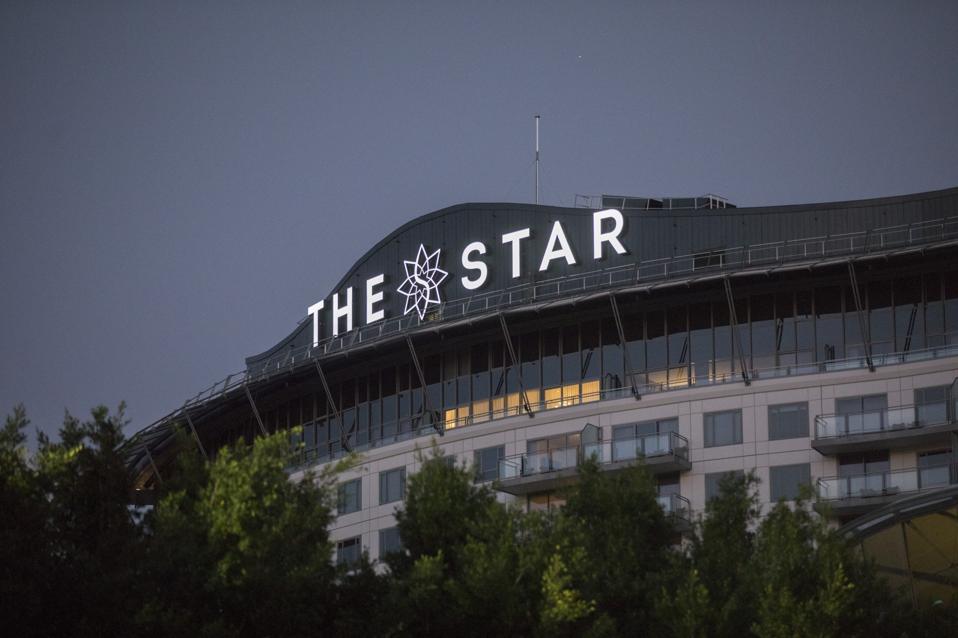Spoiler alert: shareholders are losing their shirts. Blame a series of unusual gaffes, snafus and miscommunications.

All figures in this article are in USD.
As a yarn, the meme stock MMTLP offers a bounty: allegations of market manipulation and origins in the stripper-pole business, a $3.3 million tract of West Texas land estimated by its owner to hold $9 billion of oil, a CEO who says he wasn’t aware that the stock had begun trading, a security that went for $12.26 a share in November that’s worthless today, the involvement of Congress, conspiracy enthusiasts that include a woman on YouTube who dresses in a bird costume, and Jon Stewart of all people on a livestream using the example of MMTLP to air grievances against the same stock-market regulators that torment the bird lady and her flock.
As a stock, however, MMTLP offers only heartache: after the nongovernmental Financial Industry Regulatory Authority halted MMTLP trading in December, tens of thousands of investors are discovering they may be stuck with little more than a meme.
Now, as they gather on social media to plot a path to recouping their losses, MMTLP shareholders have pinpointed the villain: FINRA, whose trading-suspension order bailed out investors who bet against the stock without owning it — a.k.a. naked short-sellers — who’d otherwise be forced to pony up. However, like everything else about MMTLP, there’s a difference of opinion on even that.
“It’s pretty clear to me that people have been swindled,” James Angel, a professor at Georgetown University’s McDonough School of Business who’s been following the MMTLP saga and owns shares, told Forbes. “But it’s not clear to me who did it.”
The upshot was a security backed by an optimistic estimate of West Texas oil reserves that was never supposed to trade being bought up on an over-the-counter marketplace by investors who had beef against short-sellers and a regulatory agency that ended up calling the whole thing off, circumventing possible panic selling but leaving shareholders with nothing.
MMTLP was odd from the beginning. It was born in December 2020 with the merger of Canadian tech company Metamaterial and the Plano, Texas-based Torchlight Energy Resources. Torchlight started life in 2010 as Pole Perfect Studios, a business that catered to the decade’s fad of pole dancing for fitness. Four years later, Torchlight bought 172,000 acres in Texas’ Orogrande Basin, southwest of the more productive Permian Basin, and subsequently claimed it could potentially extract oil worth 2,700 times what it paid for the land.
The marriage to Metamaterial was more transactional than corporate synergy. Metamaterial got Torchlight’s coveted spot on the Nasdaq exchange and 75% of the new company, Meta Materials (ticker: MMAT). Torchlight’s shareholders received a 25% cut along with something special: a novel mechanism for spinning off the Torchlight assets into an untradeable security that short-sellers couldn’t get their grubby mitts on. This financial innovation was later dubbed MMTLP.
MMTLP wasn’t supposed to be a stock. Rather, it was meant as a placeholder for a future dividend. Where the money for that dividend would come from wasn’t immediately clear. It could have been a cash payment if Meta Materials found someone willing to buy Torchlight’s Orogrande drilling rights. Or, without a sale, it could morph into shares of a new company.
What was obvious from the beginning was that this special dividend wasn’t supposed to trade. Meta Materials said as much in a July 2021 SEC filing.
But guess what? In one of the surprising lessons that MMTLP has taught us, it’s possible for a security to trade on the OTC market without the involvement of the company. (Different rules govern marketplaces like Nasdaq and the New York Stock Exchange, according to securities lawyers who spoke with Forbes.) If a security, in this case a preferred dividend share class, has a nine-digit identifying number called a CUSIP, a market-maker can register it with the OTC and begin selling.
In October 2021, that’s what happened. It came as a shock to Torchlight’s former CEO, John Brda, who told Forbes he was caught off guard and was less than thrilled with the turn of events. “MMTLP was never designed to trade,” he reiterated to Forbes.
For the next year, shares of the never-designed-to-trade MMTLP hovered in the range of $1.50. But in October, MMTLP’s price skyrocketed. It topped out at $12.26 on November 22, implying a market cap of over $2 billion. Traders had caught wind of Meta Materials’ strategy. MMTLP shares would soon be exchanged for stock in a new company, Next Bridge Hydrocarbons, that wouldn’t be publicly traded.
According to shareholders, that meant a reckoning for short-sellers — and they believed there were tons of them. Still, the reasons for this sudden uptick are, like just about everything else in this story, a matter of debate. What’s not in dispute is the controversy kicked up by subsequent events.
In November, Meta Materials announced that the distribution of MMTLP shares to Next Bridge had been approved by its board and would take place on December 14, pending FINRA’s okay. That approval came on December 6, but in a bizarre twist, FINRA’s announcement left uncertain the date for the cutoff in MMTLP trading. There was widespread confusion about whether MMTLP would continue trading until December 12 or halt on December 8.
In a widely circulated video, OTC Markets Groups’ Jeff Mendl didn’t seem to know when trading would end either. “What I can say though is MMTLP as of the end of trading on the 12th will no longer be on the OTC markets,” he said in a December 7 interview on Trader TV. But even that statement has been subject to interpretation.
Then, on December 9, FINRA issued a rare “U3” trading halt due to what it called an “extraordinary event.” The dramatic intervention effectively stopped trading of the stock forever. Shareholders accused FINRA of orchestrating a bailout for short-sellers and broker dealers.
FINRA has never explained the “extraordinary event” behind the halt, but a simple reason could be the communication breakdown: FINRA realized that brokers and their customers didn’t understand its message about when trading on MMTLP would stop. Usually, stockholders need to own a security for a certain period of time before becoming eligible for a dividend, and in order to enforce that, FINRA decided to cut off trading rather than have some investors suddenly left out of the distribution of Next Bridge shares. And since MMTLP was about to disappear, if people didn’t get Next Bridge shares, they’d be left with nothing at all.
The irony was that traders didn’t want Next Bridge shares. They wanted two additional days to offload their MMTLP shares before they got saddled with Next Bridge. Suspicious shareholders, now owners of a stock no one wants, claim that because of the proliferation of naked short-selling and counterfeit shares, FINRA knew bets against MMTLP couldn’t be covered, and the U3 halt saved short-sellers from having to pay through the nose.
FINRA, a stern referee, stuck to its story that it wasn’t protecting short-sellers because the short positions would simply migrate to Next Bridge. But the MMTLP shareholders weren’t easily convinced. In their eyes, Next Bridge would be a private company, immune to the predations of short-sellers. FINRA and a cadre of securities lawyers consulted by Forbes, however, disagreed, even if Next Bridge wouldn’t issue publicly traded shares.
“It’s the very definition of a public company,” a FINRA spokesperson told Forbes. “There’s no question.”
As of last week, Next Bridge had not registered a CUSIP for its shares.
“I can’t vouch for this kind of thing being entirely unprecedented, but it’s certainly unusual,” Charles Korsmo, a law professor at Case Western Reserve, told Forbes in an email. “It’s very common to spin off a subsidiary or part of a business to stockholders via a distribution, sometimes in connection with a merger. But in every case I’m aware of, the spun-off shares are publicly traded either immediately or soon after the spin-off. I cannot recall a situation where, as here, essentially the entire business is being spun off to public shareholders, with the resulting shares being non-public.”
he financial system is a black box, its inner workings obscure to the uninitiated, and as we discovered during the meme-stock madness of 2021, the mysteries only fuel the conspiratorial fire. But there was so much that FINRA couldn’t legally say.
While FINRA has access to the blue sheets — records of securities transactions that can help regulators identify potential market manipulation — it can’t legally release them to the public. The Depository Trust and Clearing Corporation (DTCC) could also shed light on the situation, but it didn’t respond to Forbes’ requests for comment.
In March, FINRA made its first public comment on MMTLP by publishing an FAQ on its website. Shareholders were unimpressed, branding the post “disingenuous and intentionally deceptive.” FINRA’s cause wasn’t helped when it had to correct a disputed fact about the registration of MMTLP shares. To make matters worse, FINRA admitted to a coding error that led to the MMTLP symbol’s deletion being delayed by more than two months.
MMTLP shareholders have turned to lawmakers for answers, borrowing a page from the playbook of another meme stock, GameStopGME. At least two members of Congress, Republicans Pete Sessions of Texas and Bill Posey of Florida, have written letters inquiring about the situation.
Dave Lauer, a member of FINRA’s Market Regulation Advisory Committee, has gone public with criticisms of the organization’s handling of the matter and called for “radical transparency.” Lauer was a guest on Jon Stewart’s livestream when Stewart took a question about MMTLP from a viewer. The host of “The Problem with Jon Stewart” appeared to know all about the trading halt and the ensuing controversy.
Results of a shareholder’s Freedom of Information Act request have provided ammunition for those suggesting FINRA has a hidden agenda. Emails revealed that FINRA was scrutinizing Meta Materials and MMTLP and pulling the blue sheets as early as December 5. (They also showed FINRA was receiving threats that led to an advisory for staff to work from home.) For some, the revelations showed that FINRA was investigating market-makers, not Meta Materials as the issuer of MMTLP. Another, possibly unrelated, email seemed to undermine FINRA’s claim that it was caught off guard by an “extraordinary event” in December 2022.
Some shareholders and their allies, including YouTube’s Bird Lady Rollerpigeons, have chosen to focus on Torchlight’s oil-patch acquisition. The Hudspeth County tract has produced little oil, and despite a whistleblower report and short-seller warnings, these shareholders cling to the hope that their worthless investment will at some point turn into a gusher. The ornithological oracle didn’t respond to a Forbes request for comment.
Complicating matters is that Torchlight, with its cash flow a mere trickle, relied on its own stock as currency. It was how the company repaid money borrowed from the late David Straz Jr., a Tampa banker, philanthropist and unsuccessful mayoral candidate. It also explains Torchlight’s extra antagonism toward short sellers.
Another twist in the saga: Next Bridge recently awarded option grants to executives that featured a strike price of just $1.20 a share. That implies a market capitalization of between $200 and $300 million, not even in the same galaxy as the $2 billion market cap reached at the height of the MMTLP frenzy. What’s curious is that a company that says it doesn’t want to trade publicly would make share price the basis of executive compensation, said Marc Hodak, a partner at Farient Advisors, a compensation consulting firm. Next Bridge didn’t respond to requests for comment.
“It’s atypical,” Hodak told Forbes. “Private companies offer stock options all the time, but historically they’ve been granted by companies backed by private equity firms that have three-to-five-year time horizons for a liquidity event.”
Perhaps the most baffling aspect of the MMTLP saga is the irony of traders touting the supposed treasure locked beneath the West Texas soil while desperately wanting FINRA to let them dump the stock. If they truly believe in the value of the Orogrande assets, why the eagerness to sell? It appears that for some of them, the assets were never the main attraction — the true prize was the prospect of sticking it to the short-sellers. Meanwhile, there will be lawsuits, but no more trading of MMTLP. And it’s a fat chance that any shareholder will ever lay their eyes on the blue sheets.
Maybe it’s a simpler tale: the shareholders were simply duped. As Jeff Davies, the oil and gas veteran who filed a whistleblower report on Torchlight, told Forbes: “It’s easier to fool people than it is to convince them that they’ve been fooled.”
This article was first published on forbes.com
Forbes Australia issue no.4 is out now. Tap here to secure your copy or become a member here.
Look back on the week that was with hand-picked articles from Australia and around the world. Sign up to the Forbes Australia newsletter here.


